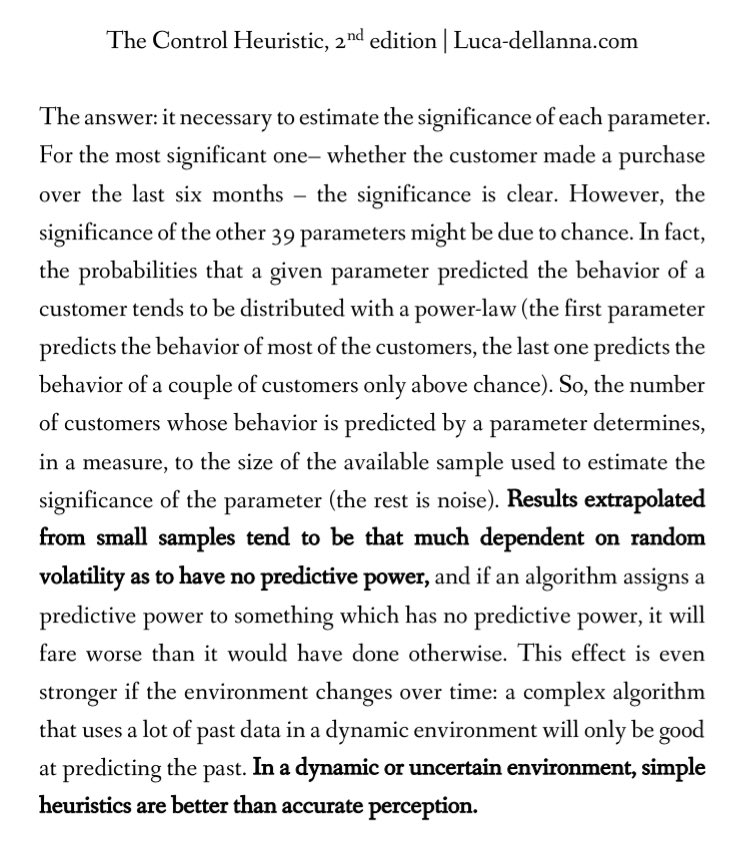
HOW TO PARETO-PRIORITIZE TWITTER
Probably, 20% of the tweets you read deliver 80% of the value of using Twitter.
You'd be a fool not to prioritize your feed.
Here's how I do it.
(thread, 1/5)
Probably, 20% of the tweets you read deliver 80% of the value of using Twitter.
You'd be a fool not to prioritize your feed.
Here's how I do it.
(thread, 1/5)
2/ First of all, I set up a Twitter List of the 20 accounts from which I get the most value, and I pin it to my Twitter app.
This is my default feed. Because there are few accounts, I can find the time to read all their tweets even on busy days.
For the rest…
This is my default feed. Because there are few accounts, I can find the time to read all their tweets even on busy days.
For the rest…
3/ For the rest, I use an app called Mailbrew
I created a digest w/ "news" that gets delivered every morning in my inbox. Because it only shows the top 3 tweets by account, it ensures I only read the best
mailbrew.com/?aff=DellAnnaL… (affiliate, but I use it daily since 2 months)
I created a digest w/ "news" that gets delivered every morning in my inbox. Because it only shows the top 3 tweets by account, it ensures I only read the best
mailbrew.com/?aff=DellAnnaL… (affiliate, but I use it daily since 2 months)
4/ Then, I set up a second digest with the next 20-40 accounts, timed to be delivered when I take my coffee break). On quiet days, I read it. On busy ones, I archive the mail.
The idea is that I prioritize the "info sources" to ensure the highest average quality for my info diet
The idea is that I prioritize the "info sources" to ensure the highest average quality for my info diet
5/ Before using that, I achieved the same result in the Twitter app by using 3 lists, one high-priority, one medium, and one low – and reading them in order, if I have time.
Mailbrew has the advantage that each list is in one email. It avoids mindless browsing in the Twitter app
Mailbrew has the advantage that each list is in one email. It avoids mindless browsing in the Twitter app
6/ Moreover, you can set the frequency to every other day or to limit the number of tweets per account per edition to the top 3 by likes and retweets.
It's not perfect, but it's much better than relying on Twitter's algorithm.
It's not perfect, but it's much better than relying on Twitter's algorithm.
7/ In conclusion, I strongly suggest that you either use Twitter lists, or Mailbrew (mailbrew.com/?aff=DellAnnaL…), or some other form of prioritization.
Not exclusively, but your time is limited, and not prioritizing would be a waste.
Not exclusively, but your time is limited, and not prioritizing would be a waste.
8/ The same, by the way, applies to reading books.
If 20% of books deliver 80% of the value, and re-reading a book gives you even just 10% additional value, say, then you're better off reading the top 20% a second time than reading a random similar amount of books from the rest.
If 20% of books deliver 80% of the value, and re-reading a book gives you even just 10% additional value, say, then you're better off reading the top 20% a second time than reading a random similar amount of books from the rest.
9/ This daily digest is a perfect way to start (you can subscribe with your email and receive it in your inbox; I curate it personally):
share.mailbrew.com/DellAnnaLuca/p…
share.mailbrew.com/DellAnnaLuca/p…
10/ BTW, this is great also if you want to help your friends who don't have Twitter to receive its best content,
or if you feel overwhelmed by Twitter and want to take a break from active participation while still being able to follow its top thinkers.
or if you feel overwhelmed by Twitter and want to take a break from active participation while still being able to follow its top thinkers.
https://twitter.com/DellAnnaLuca/status/1330898634771206144?s=20
• • •
Missing some Tweet in this thread? You can try to
force a refresh












